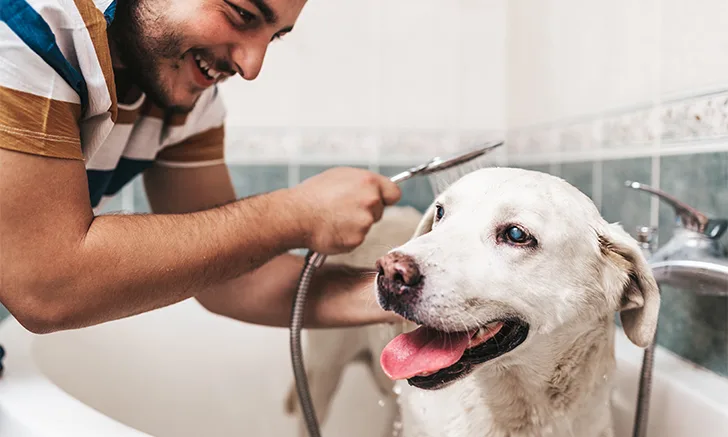Topical Solutions for Skin Infections in Allergic Pets

Sponsored by Ceva Animal Health
Despite management of their underlying disease, many allergic patients struggle with recurrent flares of bacterial overgrowth and pyoderma, which may lead to antimicrobial resistance when recurrently treated with systemic antibiotics. Familiarity with other nonsystemic protocols, such as topical therapy, may help veterinarians maintain responsible antimicrobial stewardship.
Lana’s Case
Lana, a 3-year-old spayed female golden retriever, was presented for pruritus. Physical examination revealed crusts and epidermal collarettes extending from her sternum to her axillae and moderate pruritus. Cytology showed numerous neutrophils, bacteria, and phagocytosis, and a diagnosis of bacterial overgrowth was made.
Lana was managed with a topical protocol. She was given 1 initial bath with DOUXO® S3 PYO shampoo to clean the skin and remove crusts, followed by application of DOUXO® S3 PYO mousse every 48 to 72 hours for 3 weeks.
Within 1 week, Lana had only a few crusts on the axillae, and pruritus was considered mild. Within 3 weeks, complete resolution of the pruritus and bacterial overgrowth was achieved; other treatments (eg, systemic antibiotics, steroids, oclacitinib) were never required.
Think Topical
As Lana’s case demonstrates, topical treatments alone can be sufficient in the treatment of superficial skin infections.1-3 Chlorhexidine-containing topicals have been shown to be effective in treating Staphylococcus pseudintermedius infections.1,2
In addition, topical treatments have the added benefit of reducing the risk for antimicrobial resistance.2,3 Even if resistance is already present, chlorhexidine-containing topical treatments can still be effective in treating methicillin-resistant staphylococcal infections.2,3 For these reasons, the World Association for Veterinary Dermatology recommends topical therapy as the sole on-animal antibacterial treatment for surface and superficial infections when a pet and owner are expected to be compliant.2
Furthermore, topical treatments can have other dermatologic benefits such as repairing the skin barrier,3 which may be helpful in the treatment of underlying conditions (eg, allergies).
The DOUXO® Advantage
The unique formulation of Douxo® and extensive research regarding it have set it apart from other topical products.1 Its unique active ingredient, OPHYTRIUM™, was selected to complement chlorhexidine 3% in the new DOUXO® S3 PYO products after it demonstrated excellent performance in numerous skin model studies.1,4 Ophytrium has been shown to restore the balance of the protective microbiota, soothe irritation, and strengthen the mechanical barrier of the skin by making it less permeable.4 In addition, DOUXO® S3 PYO has undergone clinical trials in which its demonstrable efficacy and safety resulted in high levels of reported satisfaction from participating owners.1
It Comes Down to Compliance
Along with safety and efficacy, compliance is an integral focus of DOUXO® products. As the World Association for Veterinary Dermatology points out, topical treatment success is contingent on owner compliance,2 and many owners may balk at the idea of wrestling their pet into the tub on multiple occasions, especially if they are already juggling other allergy treatments. However, as Lana’s case demonstrates, the DOUXO® S3 protocol requires only 1 bath, followed by maintenance with mousse treatments.1,4 That single bath can even be done at the clinic, requiring the owner to use only the mousse at home, a feasible and agreeable proposition for many owners.
Conclusion
Veterinarians should think twice before reaching for systemic antibiotics in patients with bacterial overgrowth and/or superficial pyoderma. Topical treatment with DOUXO® products is a simple solution to providing an easy-to-follow, effective plan that maintains appropriate antibiotic stewardship for patients with recurrent skin infections.
DOUXO and OPHYTRIUM are trademarks owned by Ceva Santé Animale S.A.